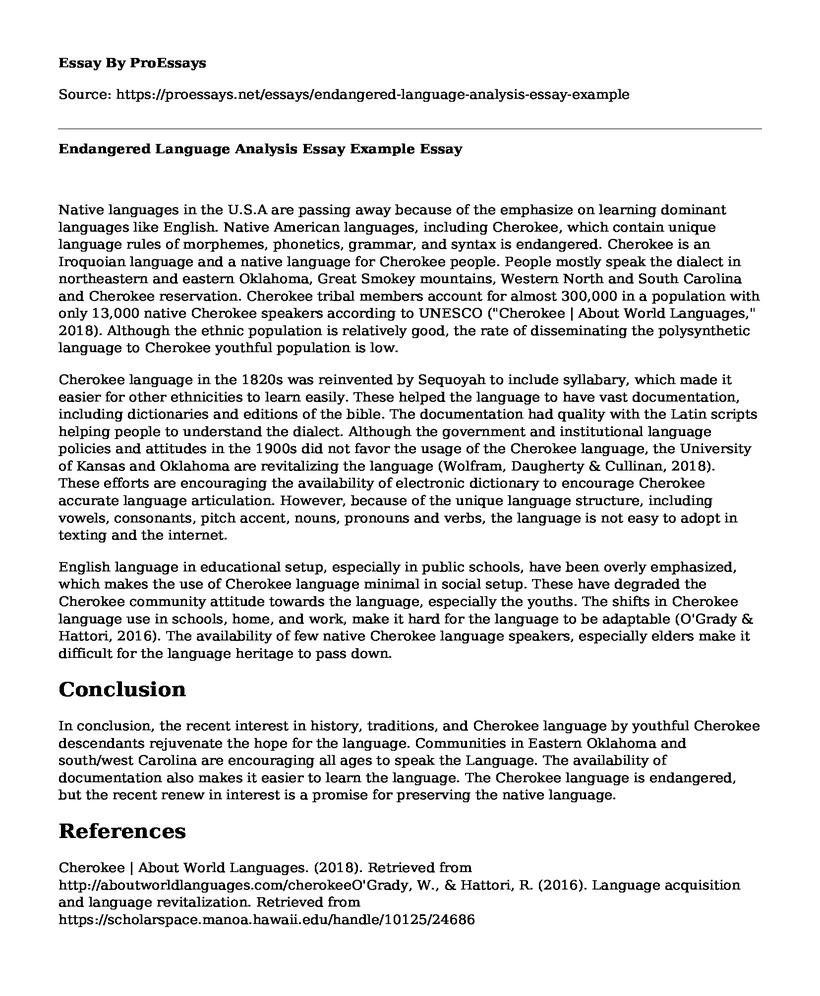Native languages in the U.S.A are passing away because of the emphasize on learning dominant languages like English. Native American languages, including Cherokee, which contain unique language rules of morphemes, phonetics, grammar, and syntax is endangered. Cherokee is an Iroquoian language and a native language for Cherokee people. People mostly speak the dialect in northeastern and eastern Oklahoma, Great Smokey mountains, Western North and South Carolina and Cherokee reservation. Cherokee tribal members account for almost 300,000 in a population with only 13,000 native Cherokee speakers according to UNESCO ("Cherokee | About World Languages," 2018). Although the ethnic population is relatively good, the rate of disseminating the polysynthetic language to Cherokee youthful population is low.
Cherokee language in the 1820s was reinvented by Sequoyah to include syllabary, which made it easier for other ethnicities to learn easily. These helped the language to have vast documentation, including dictionaries and editions of the bible. The documentation had quality with the Latin scripts helping people to understand the dialect. Although the government and institutional language policies and attitudes in the 1900s did not favor the usage of the Cherokee language, the University of Kansas and Oklahoma are revitalizing the language (Wolfram, Daugherty & Cullinan, 2018). These efforts are encouraging the availability of electronic dictionary to encourage Cherokee accurate language articulation. However, because of the unique language structure, including vowels, consonants, pitch accent, nouns, pronouns and verbs, the language is not easy to adopt in texting and the internet.
English language in educational setup, especially in public schools, have been overly emphasized, which makes the use of Cherokee language minimal in social setup. These have degraded the Cherokee community attitude towards the language, especially the youths. The shifts in Cherokee language use in schools, home, and work, make it hard for the language to be adaptable (O'Grady & Hattori, 2016). The availability of few native Cherokee language speakers, especially elders make it difficult for the language heritage to pass down.
Conclusion
In conclusion, the recent interest in history, traditions, and Cherokee language by youthful Cherokee descendants rejuvenate the hope for the language. Communities in Eastern Oklahoma and south/west Carolina are encouraging all ages to speak the Language. The availability of documentation also makes it easier to learn the language. The Cherokee language is endangered, but the recent renew in interest is a promise for preserving the native language.
References
Cherokee | About World Languages. (2018). Retrieved from http://aboutworldlanguages.com/cherokeeO'Grady, W., & Hattori, R. (2016). Language acquisition and language revitalization. Retrieved from https://scholarspace.manoa.hawaii.edu/handle/10125/24686
Wolfram, W., Daugherty, J., & Cullinan, D. (2014). On the (In) Significance of English Language Variation: Cherokee English and Lumbee English in Comparative Perspective. University of Pennsylvania Working Papers in Linguistics, 20(2), 22. Retrieved from https://repository.upenn.edu/pwpl/vol20/iss2/22/
Cite this page
Endangered Language Analysis Essay Example. (2022, Oct 23). Retrieved from https://proessays.net/essays/endangered-language-analysis-essay-example
If you are the original author of this essay and no longer wish to have it published on the ProEssays website, please click below to request its removal:
- Sociology Essay Example: Agents of Socialization
- Introducing Problem Based Learning to the University
- Focus Child Case Analysis Paper Example
- Childhood Trauma: Examining African-Americans' Participation in NCAA Division One Sports - Research Paper
- The Value of Critical Thinking as a Registered Nurse: Annotated Bibliography
- Essay Example on Team-Based Learning: A Constructivist Approach
- Diversity Gap in AP High School Education Persists Despite Increased Enrollment - Essay Sample







